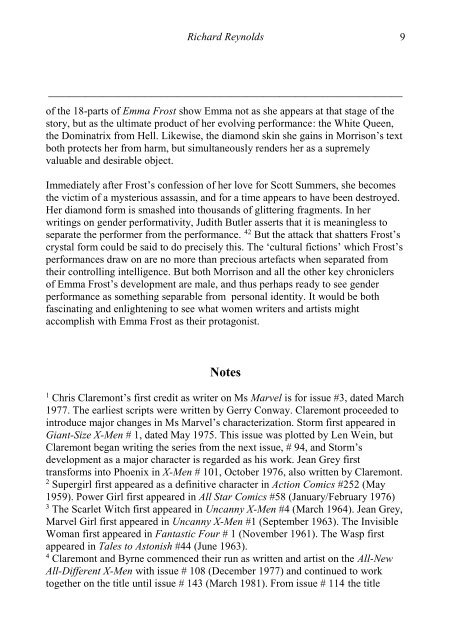Create successful ePaper yourself
Turn your PDF publications into a flip-book with our unique Google optimized e-Paper software.
<strong>Richard</strong> Reynolds<br />
9<br />
__________________________________________________________________<br />
of the 18-parts of Emma Frost show Emma not as she appears at that stage of the<br />
story, but as the ultimate product of her evolving performance: the White Queen,<br />
the Dominatrix from Hell. Likewise, the diamond skin she gains in Morrison’s text<br />
both protects her from harm, but simultaneously renders her as a supremely<br />
valuable and desirable object.<br />
Immediately after Frost’s confession of her love for Scott Summers, she becomes<br />
the victim of a mysterious assassin, and for a time appears to have been destroyed.<br />
Her diamond form is smashed into thousands of glittering fragments. In her<br />
writings on gender performativity, Judith Butler asserts that it is meaningless to<br />
separate the performer from the performance. 42 But the attack that shatters Frost’s<br />
crystal form could be said to do precisely this. The ‘cultural fictions’ which Frost’s<br />
performances draw on are no more than precious artefacts when separated from<br />
their controlling intelligence. But both Morrison and all the other key chroniclers<br />
of Emma Frost’s development are male, and thus perhaps ready to see gender<br />
performance as something separable from personal identity. It would be both<br />
fascinating and enlightening to see what women writers and artists might<br />
accomplish with Emma Frost as their protagonist.<br />
Notes<br />
1<br />
Chris Claremont’s first credit as writer on Ms Marvel is for issue #3, dated March<br />
1977. The earliest scripts were written by Gerry Conway. Claremont proceeded to<br />
introduce major changes in Ms Marvel’s characterization. Storm first appeared in<br />
Giant-Size X-Men # 1, dated May 1975. This issue was plotted by Len Wein, but<br />
Claremont began writing the series from the next issue, # 94, and Storm’s<br />
development as a major character is regarded as his work. Jean Grey first<br />
transforms into Phoenix in X-Men # 101, October 1976, also written by Claremont.<br />
2<br />
Supergirl first appeared as a definitive character in Action Comics #252 (May<br />
1959). Power Girl first appeared in All Star Comics #58 (January/February 1976)<br />
3<br />
The Scarlet Witch first appeared in Uncanny X-Men #4 (March 1964). Jean Grey,<br />
Marvel Girl first appeared in Uncanny X-Men #1 (September 1963). The Invisible<br />
Woman first appeared in Fantastic Four # 1 (November 1961). The Wasp first<br />
appeared in Tales to Astonish #44 (June 1963).<br />
4<br />
Claremont and Byrne commenced their run as written and artist on the All-New<br />
All-Different X-Men with issue # 108 (December 1977) and continued to work<br />
together on the title until issue # 143 (March 1981). From issue # 114 the title


